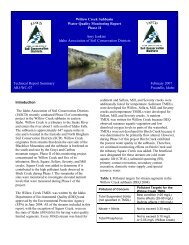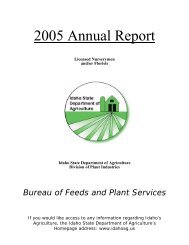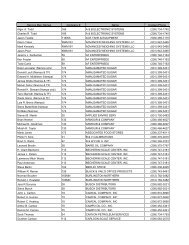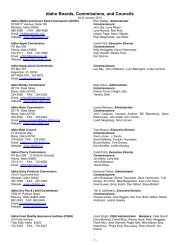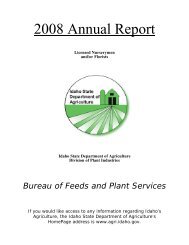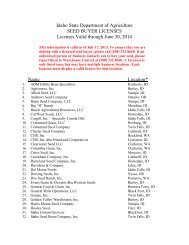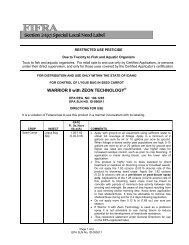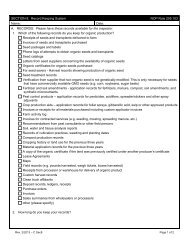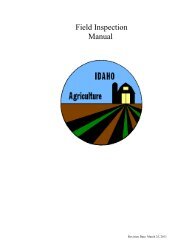2008 Statewide Strategic Plan for Eurasian Watermilfoil in Idaho
2008 Statewide Strategic Plan for Eurasian Watermilfoil in Idaho
2008 Statewide Strategic Plan for Eurasian Watermilfoil in Idaho
Create successful ePaper yourself
Turn your PDF publications into a flip-book with our unique Google optimized e-Paper software.
Recommendation 5.1: Additions to the Invasive Species List.<br />
Additional aquatic plants need to be added to the noxious weeds rules to prohibit <strong>in</strong>troduction of<br />
known noxious <strong>in</strong>vasive aquatic weeds <strong>in</strong>to the state to protect the natural beauty and value of<br />
<strong>Idaho</strong> waters. Serious consideration should be given to revision of current draft legislation to<br />
designate the follow<strong>in</strong>g (and possibly others) to the statewide EDRR Noxious Weed List:<br />
Egeria sp.<br />
Eichhornia sp.<br />
Hydrilla verticillata<br />
Hydrocharis sp.<br />
Trapa sp.<br />
Phragmites sp.<br />
Cabomba sp.<br />
Potamogeton crispus<br />
Hydrocharis morsus-ranae<br />
Further it is recommended that:<br />
• A panel consist<strong>in</strong>g of botanists, <strong>in</strong>vasive aquatic plant experts and regulators from<br />
adjacent states should be convened to review additions to the above list. The movement<br />
of <strong>in</strong>vasive plants is at the very least a regional issue.<br />
• <strong>Plan</strong>t surveys should be conducted of <strong>Idaho</strong> lakes and waterways to determ<strong>in</strong>e the extent<br />
of these <strong>in</strong>vasive plants, if present, which might allow a rapid response and eradication<br />
ef<strong>for</strong>t.<br />
• Internet sales and culture of plants <strong>for</strong> sale <strong>in</strong> private aquaculture ponds (particularly <strong>in</strong><br />
Eastern <strong>Idaho</strong>) may be a significant source of potentially <strong>in</strong>vasive aquatic plants that<br />
should be monitored on a regular basis.<br />
• Tra<strong>in</strong><strong>in</strong>g should be sponsored by ISDA <strong>for</strong> persons <strong>in</strong>volved with monitor<strong>in</strong>g and manag<strong>in</strong>g<br />
<strong>Idaho</strong> waters <strong>in</strong> order to identify all <strong>in</strong>vasive aquatic weeds so that appropriate<br />
management ef<strong>for</strong>ts can be quickly applied.<br />
• ISDA should develop a program to <strong>in</strong>spect nurseries and retail outlets that grow or sell<br />
aquatic and wetland plants. Bus<strong>in</strong>esses and activities of persons that engage <strong>in</strong> aquatic<br />
and wetland plant revegetation or restoration should be <strong>in</strong>spected or permitted by the<br />
appropriate agency to ensure that plants are not collected and transported from a<br />
waterbody <strong>in</strong>fested with EWM or other noxious weed to previously un<strong>in</strong>fested <strong>Idaho</strong><br />
waters.<br />
ISDA Response: ISDA staff agrees with this recommendation and has made progress <strong>in</strong> this<br />
area by propos<strong>in</strong>g the addition of several noxious aquatic weeds to its Noxious Weed Rule.<br />
The Rule changes go be<strong>for</strong>e the <strong>Idaho</strong> State Agriculture Committee <strong>in</strong> January, 2007. Once<br />
these species are added to the list, <strong>in</strong>spections of nurseries and pet shops will be carried out<br />
by ISDA staff. Additionally, ISDA hopes to support work to encourage <strong>in</strong>creased skills <strong>in</strong><br />
aquatic plant identification <strong>in</strong> <strong>Idaho</strong>.<br />
Issue 6.0: Eradication goal<br />
The stated objective of the <strong>Idaho</strong> State Department of Agriculture’s (ISDA) EWM Eradication<br />
Program is to eradicate EWM from all the state’s <strong>in</strong>fested waterways. The def<strong>in</strong>ition of<br />
“eradication” <strong>in</strong> the authoriz<strong>in</strong>g legislation is “Eradication means the elim<strong>in</strong>ation of a noxious weed<br />
based on absence as determ<strong>in</strong>ed by a visual <strong>in</strong>spection by the control authority dur<strong>in</strong>g the current<br />
grow<strong>in</strong>g season” (<strong>Idaho</strong> Code Section 22-2402 (10)). This is an operational def<strong>in</strong>ition, which<br />
provides guidance to project managers <strong>in</strong> the field, and provides a measurable objective to<br />
program managers at ISDA. The EWM Program Review Panel understands that, <strong>in</strong> the context of<br />
the ISDA EWM Eradication Program, this def<strong>in</strong>ition <strong>in</strong>cludes the mean<strong>in</strong>g that, to be considered<br />
eradicated, all EWM must be controlled <strong>in</strong> a given waterway.<br />
Judith Myers, <strong>in</strong> a paper on pest eradication <strong>in</strong> general, has def<strong>in</strong>ed the term “eradication” <strong>in</strong> a<br />
more abstract way as “Eradication is the removal of every potentially reproduc<strong>in</strong>g <strong>in</strong>dividual of a<br />
65



